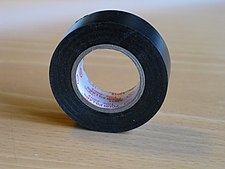Electrical tape
Electrical tape (or insulating tape) is a type of pressure-sensitive adhesive tape used primarily to insulate electrical wire and cable splices. This type of tape is capable of withstanding conditions of extreme temperatures, corrosion, humidity and high voltages. The tape is made of thin PVC material, usually 14mm wide; one side of the tape is impregnated with an adhesive. PVC has been chosen because it is a low-cost, flexible material and has excellent electrical insulating properties, although it has the disadvantage of hardening with time and heat.

Development
changeIn the 1950s, vinyl emerged as a highly versatile material for a wide range of uses, from shower curtains to cable insulation. However, getting it to have the right characteristics to make a tape required a significant research effort.
An important ingredient in vinyl film was tricresyl phosphate (TCP), which was used as a plasticizer. Unfortunately, the TCP had a tendency to migrate, which gave the surface of the tape an oily quality, affecting the adhesive property of the tape. Therefore, the 3M research team began work on creating a reliable vinyl tape that had the right characteristics in terms of electrical insulation, physical resistance and chemical properties.
Experiments were carried out combining new plasticizers with the vinyl resin, which was white and floury in consistency. Finally in January 1946, the 3M team of inventors Snell, Oace, and Eastwood applied for a patent for a vinyl electrical insulating tape with a plasticizer and a non-sulfur-based rubbery adhesive. The first commercialized version of the tape was sold for wrapping wires.[1]
References
change- ↑ "Electrical Tape History". www.3m.com. Archived from the original on 2020-07-30. Retrieved 2020-05-21.